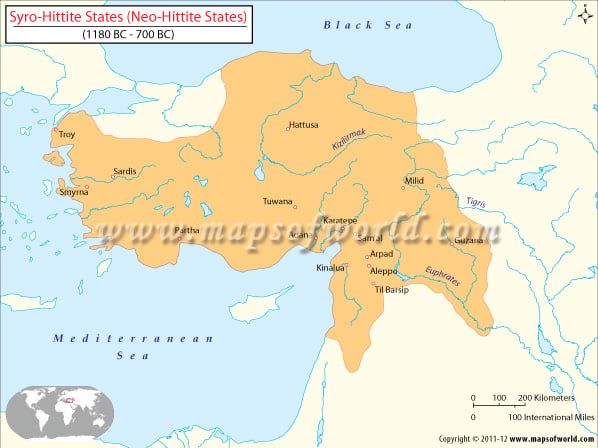Hittite King Hattusili III was well known for his near-victory against the Egyptian Pharaoh Ramses II in the Battle of Kadesh in the year 1274 BC. Hattusili III and his Queen Puduhepa consolidated the Hittite empire by forging royal alliances and peace treaties with neighboring and vassal states. By 1237 BC, Hattusili III fell terminally sick and died. The Hittite Empire and the capital Hattusha collapsed unceremoniously.
By 1180 BC, the Neo-Hittite states, also referred to as the Syro-Hittite states, rose to prominence to the east of the erstwhile Hittite Empire. This corroborates historic evidence that a mass exodus of the population from Anatolia into Syria occurred and that the Hittite people survived in these Syro-Hittite states.
The States
Carchemish: Carchemish was possibly the most significant of the Luwian (or northern Syro-Hittte) states. The rulers of Carchemish were known to have been related to the ruling dynasty of the Hittite Empire, and the fall of the empire did not significantly affect this state.
Milid (Kammanu): Milid was another important Syro–Hittite state. The Luwian influence on the culture of Milid is unmistakable. Milid seems to have been the capital of Kammanu at times. By itself, the city was a hub of trade, culture, and political activity.
Que: The states of Que and Hilakku were known to foster close ties with the Aramaeans. The states joined forces with the Aramaeans to offer resistance to Shalmaneser III when he attacked in 853 BC.
Hilakku: The mountainous state of Hilakku, to the west of the Que plains, harbored close ties with the Assyrians and the Aramaeans.
Tabal: The state of Tabal was made up of many strong cities such as Ishtunda, Shinukhtu, Hupisna, and Tyana.
Gurgum: Gurgum, with its cultural hub at Margasi, was an important political entity until about 740 BC, when it fell to the invasions of the Assyrian King Tiglath-Pileser.
Kummuhu: A mention of Kummuhu is found in Urartian texts. The Urartian rulers Argishti I and Sarduri II invaded and conquered Kummuhu (in about 750 BC). Kummuhu is believed to have had excellent diplomatic and trade relations with Babylon and Egypt.
The southern Syro-Hittite states were ruled by Aramaeans from about 1000 BC. Though there were very cordial relations between the states (Bit-Adini, Bit-Agusi, Ain-Dara, Hamath, Bit-Gabbari, Pattina, Hatarikka-Luhuti, and Bit-Bahiani), and each was an independent political entity. Among the more important cities of the southern states were Aleppo, Arpad, Kinalua, Guzana, Nampigi, Sam’al, and Til Barsip.

